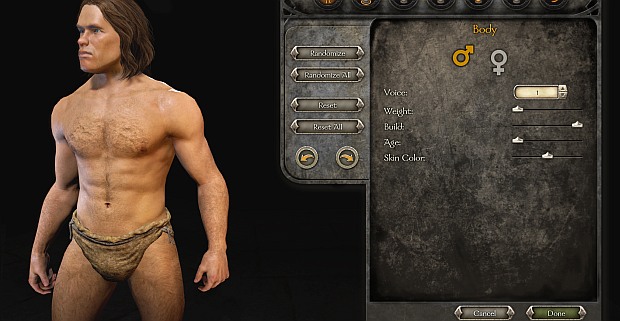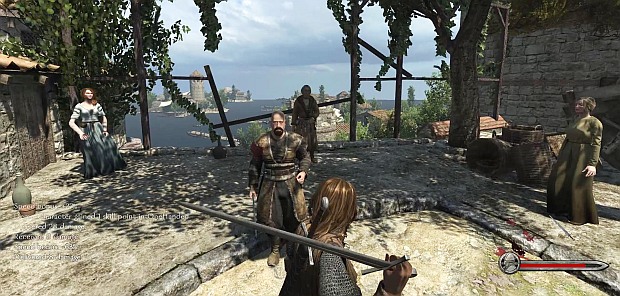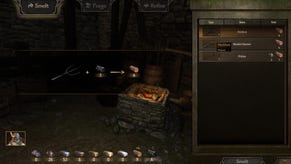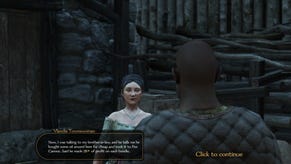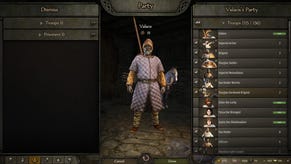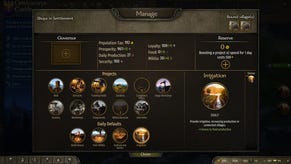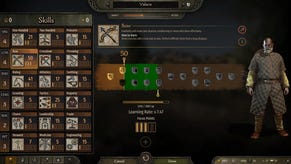Mount & Blade 2: Bannerlord Aims To Be Friendlier
Another Captain Smith
This is an embarrassing admission: when I first played the original Mount & Blade I spent twenty minutes walking around trying to find other players and confused by the mostly empty villages I found instead. I had thought it was an MMO.
This makes me the person in the world best equipped to write about its sequel, Mount & Blade II: Bannerlord [official site], which is aiming to make many of the series' systems easier to grasp for idiots like me.
One thing I can confirm: its villages would no longer feel empty, even if you're still not going to find other players inside. Mount & Blade 2 is running on a whole new engine that is far higher detail than its predecessor. This is demonstrated when developer touring us around the world visits a tavern and there two-dozen people inside, drinking, eating, serving behind the bar, or sat in the middle, as one man is, playing a lute.
The greater amount of detail is apparent everywhere. The new character creator allows you to form people that look like people, instead of gurning smudges. There are sliders for changing hair and adding facial asymmetry and face paint and switching up body shape on your soon-to-be-heroic-or-dead man or woman. The developer from TaleWorlds further highlights its flexibility with the by now obligatory recreations of famous faces, so I can confirm that it produces a pretty convincing Arnold Schwarzenegger, Benedict Cumberbatch and Albert Einstein.
There's also now scenery that changes with the seasons, including grass that's more than a green texture stretched unconvincingly across a vast plain, and six different cultures to visit, each with its own unique boardgame. Yes, you heard: that's six times more boardgames than The Witcher 3 and its monoboardgame world of Gwent.
This is likely of interest if you're a seasoned Mount & Blade player, ready to Captain Smith yourself across a fancier world. It's likely less enticing if you, like many, arrived at a village in Mount & Blade or any of its spin-offs, were presented with a menu containing precisely ten different options, and thought, "Oh shit, I thought this would be like Skyrim."
TaleWorlds are aware of that problem. A lot of what they talk about are minor tweaks to existing menus - making negotiations and diplomacy happen on a single, robust and clearly explained screen, for example. These things look nice, and TaleWorlds say that they've been designed so that every time they add a new feature they can plug it into the same menu system. The example they give is that, if they add a system whereby you can marry a lord's daughter, then you can barter for their daughter via this same screen as you'd use to end a war or buy bread. Grim - but functionally convenient.
The biggest addition for new players however is that there's now a proper storyline and quest system designed to introduce players to Mount & Blade's systems.
In the quest example we're shown, the developer meets a man in the pub who has just had his horse stolen. He'd be grateful if you helped him get it back. If you agree, he leads you off to the people responsible elsewhere in town, giving you the opportunity to talk to their leader and compel them to return your new friend's horse. When they refuse, you fight one of their heavies in sword combat in order to teach them a lesson. It's an opportunity to teach the player a lesson too, letting them get used to conversation and combat systems in an environment less intimidating than the wilderness.
Suitably impressed, the horseless bar friend joins up to your squad of merry men, which comes in handy not long after when - in the wilderness - we meet more horse bandits. We get a greater glimpse at the combat here, as a dozen or so people on the battlefield manouver around, stabbing and swinging, while the developer moves among them on horseback. Combat is meant to be deeper than previous iterations of the game, taking into account timing and previous attacks, but it's more about subtle differences than a total overhaul. TaleWorlds say they want it to "still be very accessible and intuitive."
As per previous games in the series, the aim is still to amass power and wealth by capturing or otherwise coming to rule towns. You have new methods of doing so. For starters, there's a new weapon crafting system which physically simulates the weapons you make in an effort to mimic how they would function in real life. That means that change to the appearance of a sword changes its balance and speed, and produces slight changes to its user's swing. Beyond that, there's the addition of siege weaponry, which look like they might be impressive when finished. We're shown catapults launching boulders as well as siege towers and battering rams, and we're told that everything is usable by players, but we never actually see a boulder strike anything to find out what kind of effect it creates.
If the battle you have does end up being particularly impressive to watch, the game will now ship with a replay editor in which you can move the camera and add post-processing effects to commemorate your greatest victories or most embarrassing defeats. It's a nice extra feature.
The Mount & Blade games have found an audience despite their fiddlyness by offering a historical fantasy in which you have a lot of control over your role and objectives within the world. Mount & Blade 2 looks to be a richer, more accessible take on the same ideas. And I can confirm: it's still not an MMO.



